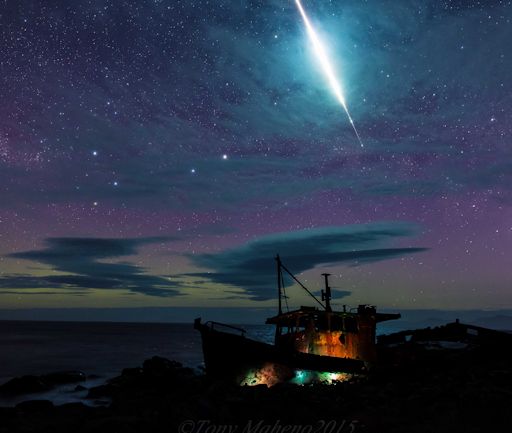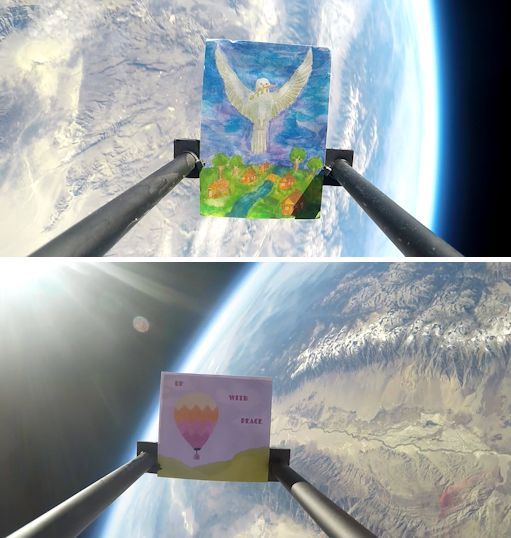Marianne's Heaven On Earth Aurora Chaser Tours Chasethelighttours.co.uk invites you to join them in their quest to find and photograph the Aurora Borealis. Experience the winter wonderland in the Tromsø Area. | | | GLANCING-BLOW CME EXPECTED LATER TODAY: A CME (movie) hurled into space by sunspot AR2449 on Nov. 9th is expected to deliver a glancing blow to Earth's magnetic field later today. NOAA forecasters estimate a 60% chance of geomagnetic storms when the CME arrives on Nov. 11-12. Aurora alerts: text or voice SOUTHERN LIGHTS: For the third day in a row, Earth is passing through a stream of high-speed solar wind flowing from a coronal hole on the sun. Currently, solar wind speeds are topping 700 km/s (1.6 million mph), sparking displays like this one photographed by Tony Maheno of Bluff, Southland, New Zealand: 
"While photographing the southern lights near the shipwreck Olivia, I caught a meteor shooting from above and burning out as it passed by," says Maheno. "I could see the smoke vapours after it passed." The meteor was, of course, a Taurid fireball. Two weeks after it began, the annual Taurid meteor shower is still underway, and it is visible from both hemispheres of our planet. The Taurids of 2015 are expecially rich in fireballs because Earth is inside an extra-gravelly swarm of material associated with parent Comet Encke. Aurora watchers who stay outdoors for more than a few hours stand a good chance of seeing one explode with their own eyes. Aurora alerts: text or voice Realtime Aurora Photo Gallery NOBEL ART EXHIBIT AT THE EDGE OF SPACE: In Barcelona, Spain, the 2015 World Summit of Nobel Peace Laureates is about to begin. From Nov. 13th through 15th, more than a dozen Nobel Laureates will gather to promote global peace and freedom. As they work, the Laureates will be surrounded by hundreds of peace-themed paintings created by school children around the world. A preview of this unique exhibit was recently seen ... at the edge of space: 
Both were flown to the stratosphere in October onboard an Earth to Sky Calculus research balloon. The top frame shows Dove of Peace, a painting by Aleksandra Manafova, 11, of St. Petersburg, Russia. The bottom frame displays Up with Peace, by Pace Academy freshman Caelan Corbally, 15, of Atlanta, Georgia. Linden Longino, CEO of International Paint Pals, is organizing the Nobel Art exhibit, and he aranged to have these samples sent to the stratosphere. "One hundred countries were invited to have children participate in the exhibition, and 83 said 'yes'--a phenomenal response," says Longino. "Out of 2,000 works of art we received, the best 166 (two from each country) were chosen to be displayed at the Nobel Summit. Of those, two were further selected for the 'space exhibit' because of their relevance to flight and their 'uplifting' nature." Longino's donation of $1000 to Earth to Sky Calculus not only propelled two fine pieces of art to the edge of space, but also allowed the students of Earth to Sky to continue their ongoing measurements of cosmic radiation in the stratosphere with two research balloon flights in October. Thank you, Linden! Realtime Space Weather Photo Gallery
Realtime Taurid Photo Gallery
Realtime Meteor Photo Gallery Every night, a network of NASA all-sky cameras scans the skies above the United States for meteoritic fireballs. Automated software maintained by NASA's Meteoroid Environment Office calculates their orbits, velocity, penetration depth in Earth's atmosphere and many other characteristics. Daily results are presented here on Spaceweather.com. On Nov. 11, 2015, the network reported 34 fireballs.
(18 sporadics, 16 Northern Taurids)  In this diagram of the inner solar system, all of the fireball orbits intersect at a single point--Earth. The orbits are color-coded by velocity, from slow (red) to fast (blue). [Larger image] [movies] Potentially Hazardous Asteroids ( PHAs) are space rocks larger than approximately 100m that can come closer to Earth than 0.05 AU. None of the known PHAs is on a collision course with our planet, although astronomers are finding new ones all the time. On November 11, 2015 there were 1633 potentially hazardous asteroids. Notes: LD means "Lunar Distance." 1 LD = 384,401 km, the distance between Earth and the Moon. 1 LD also equals 0.00256 AU. MAG is the visual magnitude of the asteroid on the date of closest approach. | | Cosmic Rays in the Atmosphere | | Situation Report -- Oct. 30, 2015 | Stratospheric Radiation (+37o N) | | Cosmic ray levels are elevated (+6.1% above the Space Age median). The trend is flat. Cosmic ray levels have increased +0% in the past month. | | Sept. 06: 4.14 uSv/hr (414 uRad/hr) | | Sept. 12: 4.09 uSv/hr (409 uRad/hr) | | Sept. 23: 4.12 uSv/hr (412 uRad/hr) | | Sept. 25: 4.16 uSv/hr (416 uRad/hr) | | Sept. 27: 4.13 uSv/hr (413 uRad/hr) | | Oct. 11: 4.02 uSv/hr (402 uRad/hr) | | Oct. 22: 4.11 uSv/hr (402 uRad/hr) | These measurements are based on regular space weather balloon flights: learn more. Approximately once a week, Spaceweather.com and the students of Earth to Sky Calculus fly "space weather balloons" to the stratosphere over California. These balloons are equipped with radiation sensors that detect cosmic rays, a surprisingly "down to Earth" form of space weather. Cosmic rays can seed clouds, trigger lightning, and penetrate commercial airplanes. Our measurements show that someone flying back and forth across the continental USA, just once, can absorb as much ionizing radiation as 2 to 5 dental X-rays. Here is the data from our latest flight, Oct. 22nd: 
Radiation levels peak at the entrance to the stratosphere in a broad region called the "Pfotzer Maximum." This peak is named after physicist George Pfotzer who discovered it using balloons and Geiger tubes in the 1930s. Radiation levels there are more than 80x sea level. Note that the bottom of the Pfotzer Maximim is near 55,000 ft. This means that some high-flying aircraft are not far from the zone of maximum radiation. Indeed, according to the Oct 22th measurements, a plane flying at 45,000 feet is exposed to 2.79 uSv/hr. At that rate, a passenger would absorb about one dental X-ray's worth of radiation in about 5 hours. The radiation sensors onboard our helium balloons detect X-rays and gamma-rays in the energy range 10 keV to 20 MeV. These energies span the range of medical X-ray machines and airport security scanners. | | The official U.S. government space weather bureau | | | The first place to look for information about sundogs, pillars, rainbows and related phenomena. | | | Researchers call it a "Hubble for the sun." SDO is the most advanced solar observatory ever. | | | 3D views of the sun from NASA's Solar and Terrestrial Relations Observatory | | | Realtime and archival images of the Sun from SOHO. | | | from the NOAA Space Environment Center | | | the underlying science of space weather | | 
